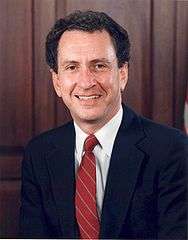United States Senate election in Pennsylvania, 1992
| | |||||||||||||||||||||||
| |||||||||||||||||||||||
| |||||||||||||||||||||||
|
| |||||||||||||||||||||||
| County results | |||||||||||||||||||||||
| |||||||||||||||||||||||
The 1992 United States Senate election in Pennsylvania was held on November 3, 1992. Incumbent Republican U.S. Senator Arlen Specter won re-election to a third term.
Major candidates
Democratic
- Lynn Yeakel, millionaire[1] director of women's studies at Drexel University College of Medicine and daughter of former U.S. Congressman Porter Hardy of Virginia[2] (from Montgomery County)
Republican
- Arlen Specter, incumbent U.S. Senator (from Philadelphia County)
Campaign
Despite his powerful position in the Senate, Specter had numerous problems entering the election. A moderate who generally received only tepid support from his party's conservative wing, he was criticized by the right for opposing Ronald Reagan's nomination of Robert Bork to the Supreme Court. Specter subsequently faced a primary challenge from an ultra-conservative State Representative named Stephen Freind; although the incumbent won handily, the battle was expensive and featured many damaging attack ads. The senator was also highly targeted by women's groups for his involvement in the Clarence Thomas proceedings; in his questioning of Anita Hill, Specter appeared to show no sympathy for her allegations of sexual harassment. Furthermore, President Bush's popularity was rapidly declining in the state over high unemployment rates and was subsequently dragging down Republican candidates.[3]
Yeakel won the five-way primary with 45% of the vote, easily defeating the endorsed candidate, Lieutenant Governor Mark Singel, in an election cycle dubbed by pundits as the "year of the woman." Polls put her ahead of Specter by double digits. But Specter ran a campaign that was praised by political analysts for being almost flawless.[3] Despite Yeakel's personal wealth, her inexperience in politics led to fund raising problems; in turn, Specter ran television ads long before the Democrat. The moderate Specter portrayed Yeakel, despite her liberal attitude, as a member of an elitist blue-blood family; he emphasized her father's votes against the Civil Rights Act of 1964 while in Congress, her affiliation with an all-white country club, and her church's minister's vocal criticism of the Israeli government.[4][5]
Despite her mistakes, including a frequent tendency to mispronounce the names of places in which she was campaigning, Yeakel continued to perform solidly, and on Election Day, she captured by large numbers the traditional Democratic strongholds of the state, such as Pittsburgh, Scranton, and Erie. However, Specter undercut Yeakel's support in the state's most critical Democratic county: Philadelphia. Specter campaigned hard in black neighborhoods and received the endorsement of the NAACP. Furthermore, he capitalized on the ambivalence of many Philadelphia Democratic leaders to Yeakel, a self-described reform candidate; as a result, the hugely Democratic city featured a higher than anticipated vote for Specter. Also critical to the campaign was Specter's grassroots involvement in Yeakel's base, the traditionally GOP but Democratic-trending suburbs of Philadelphia.[3]
Results
| Party | Candidate | Votes | % | ± | |
|---|---|---|---|---|---|
| Republican | Arlen Specter | 2,358,125 | 48.9 | ||
| Democratic | Lynn Yeakel | 2,244,966 | 46.6 | ||
| Libertarian | John Perry | 219,319 | 4.6 | ||
References
- ↑ "Yeakel to oppose Specter, main target in Senate race". Pittsburgh Post-Gazette. 29 April 1992. Retrieved 20 August 2010.
- ↑ "Yeakel, Lynn". OurCampaigns. Retrieved 20 August 2010.
- 1 2 3 Kennedy, John J. (2006). Pennsylvania Elections: Statewide Contests from 1950-2004. United Press of America. ISBN 9780761832799.
- ↑ Kornacki, Steve (30 April 2009). "Lynn Yeakel Isn't Angry Anymore". New York Observer. Retrieved 20 August 2010.
- ↑ http://articles.philly.com/1992-11-15/news/26007483_1_lynn-yeakel-pastor-first-church
- ↑ "Statistics of the Congressional and Presidential Election of November 3, 1992" (PDF). Office of the Clerk of the U.S. House. Retrieved 8 July 2014.



